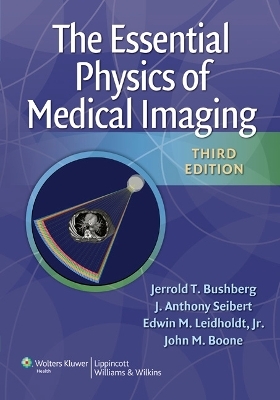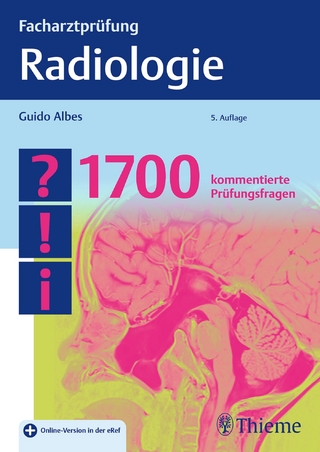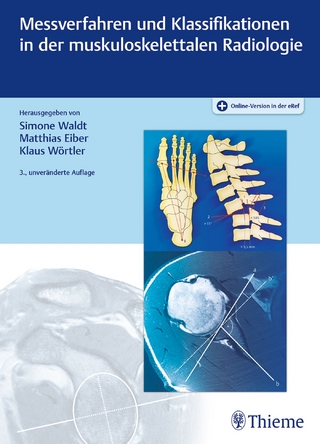
The Essential Physics of Medical Imaging
Lippincott Williams and Wilkins (Verlag)
978-0-7817-8057-5 (ISBN)
- Titel erscheint in neuer Auflage
- Artikel merken
This renowned work is derived from the authors' acclaimed national review course (“Physics of Medical Imaging") at the University of California-Davis for radiology residents. The text is a guide to the fundamental principles of medical imaging physics, radiation protection and radiation biology, with complex topics presented in the clear and concise manner and style for which these authors are known. Coverage includes the production, characteristics and interactions of ionizing radiation used in medical imaging and the imaging modalities in which they are used, including radiography, mammography, fluoroscopy, computed tomography and nuclear medicine. Special attention is paid to optimizing patient dose in each of these modalities. Sections of the book address topics common to all forms of diagnostic imaging, including image quality and medical informatics as well as the non-ionizing medical imaging modalities of MRI and ultrasound.
The basic science important to nuclear imaging, including the nature and production of radioactivity, internal dosimetry and radiation detection and measurement, are presented clearly and concisely. Current concepts in the fields of radiation biology and radiation protection relevant to medical imaging, and a number of helpful appendices complete this comprehensive textbook. The text is enhanced by numerous full color charts, tables, images and superb illustrations that reinforce central concepts. The book is ideal for medical imaging professionals, and teachers and students in medical physics and biomedical engineering. Radiology residents will find this text especially useful in bolstering their understanding of imaging physics and related topics prior to board exams.
-- NEW Four-color throughout
-- NEW Companion website with fully searchable text and images
--Basic line drawings help to explain concepts
--Comprehensive coverage of diagnostic imaging modalities
--Superb writing style of the author team helps make a difficult subject approachable and engaging
Preface to the Third Edition
Foreword
Acknowledgements
Section I: Basic Concepts
1 Introduction to Medical Imaging
1.1 The Modalities
1.2 Image Properties
2 Radiation and the Atom
2.1 Radiation
2.2 Structure of the Atom
3 Interaction of Radiation with Matter
3.1 Particle Interactions
3.2 X-ray and Gamma-Ray Interactions
3.3 Attenuation of x-rays and Gamma Rays
3.4 Absorption of Energy from X-rays and Gamma Rays
3.5 Imparted Energy, Equivalent Dose, and Effective Dose
4 Image Quality
4.1 Spatial Resolution
4.2 Convolution
4.3 Physical Mechanisms of Blurring
4.4 The Frequency Domain
4.5 Contrast Resolution
4.6 Noise Texture: The Noise Power Spectrum
4.7 Contrast
4.8 Contrast-to-Noise Ratio
4.9 Signal-to-Noise Ratio
4.10 Contrast-Detail Diagrams
4.11 Detective Quantum Efficiency
4.12 Receiver Operating Characteristic Curves
5 Medical Imaging Informatics
5.1 Analog and Digital Representation of Data
5.2 Digital Radiological Images
5.3 Digital Computers
5.4 Information Storage Devices
5.5 Display of Digital Images
5.6 Computer Networks
5.7 PACS and Teleradiology
5.8 Image Processing
5.9 Security, Including Availablility
Section II: Diagnostic Radiology
6 x-ray Production, X-ray Tubes, and x-ray Generators
6.1 Production of x-rays
6.2 x-ray Tubes
6.3 x-ray Generators
6.4 Power Ratings and Heat Loading and Cooling
6.5 Factors Affecting x-ray Emission
7 Radiography
7.1 Geometry of Projection Radiography
7.2 Screen-Film Radiography
7.3 Computed Radiography
7.4 Charge-Coupled Device and Complementary Metal-Oxide Semiconductor detectors
7.5 Flat Panel Thin-Film-Transistor Array Detectors
7.6 Technique Factors in Radiography
7.7 Scintillators and Intensifying Screens
7.8 Absorption Efficiency and Conversion Efficiency
7.9 Other Considerations
7.10 Radiographic Detectors, Patient Dose, and Exposure Index
7.11 Dual-Energy Radiography
7.12 Scattered Radiation in Projection Radiographic Imaging
8 Mammography
8.1 x-ray Tube and Beam Filtration
8.2 x-ray Generator and Phototimer System
8.3 Compression, Scattered Radiation, and Magnification
8.4 Screen-Film Cassettes and Film Processing
8.5 Digital Mammography
8.6 Radiation Dosimetry
8.7 Regulatory Requirements
9 Fluoroscopy
9.1 Functionality
9.2 Fluoroscopic Imaging Chain Components
9.3 Fluoroscopic Detector Systems
9.4 Automatic Exposure Rate Control
9.5 Fluoroscopy Modes of Operation
9.6 Image Quality in Fluoroscopy
9.7 Fluoroscopy Suites
9.8 Radiation Dose
10 Computed Tomography
10.1 Clinical Use
10.2 CT System Designs
10.3 Modes of CT Acquisition
10.4 CT Reconstruction
10.5 Image Quality in CT
10.6 CT Image Artifacts
10.7 CT Generations
11 X-ray Dosimetry in Projection Imaging and Computed Tomography
11.1 Attenuation of X-rays in Tissue
11.2 Dose-Related Metrics in Radiography and Fluoroscopy
11.3 Monte Carlo Dose Computation
11.4 Equivalent Dose
11.5 Organ Doses from X-ray Procedures
11.6 Effective Dose
11.7 Absorbed Dose in Radiography and Fluoroscopy
11.8 CT Dosimetry and Organ Doses
11.9 Computation of Radiation Risk to the Generic Patient
11.10 Computation of Patient-Specific Radiation Risk Estimates
11.11 Diagnostic Reference Levels
11.12 Increasing Radiation Burden from Medical Imaging
11.13 Summary: Dose Estimation in Patients
12 Magnetic Resonance Basics: Magnetic Fields, Nuclear Magnetic Characteristics, Tissue Contrast, Image Acquisition
12.1 Magnetism, Magnetic Fields, and Magnets
12.2 The Magnetic Resonance Signal
12.3 Magnetization Properties of Tissues
12.4 Basic Acquisition Parameters
12.5 Basic Pulse Sequences
12.6 MR Signal Localization
12.7 “K-Space” Data Acquisition and Image Reconstruction
12.8 Summary
13 Magnetic Resonance Imaging: Advanced Image Acquisition Methods, Artifacts, Spectroscopy, Quality Control, Siting, Bioeffects, and Safety
13.1 Image Acquisition Time
13.2 MR Image Characteristics
13.3 Signal from Flow
13.3 Perfusion and Diffusion Contrast Imaging
13.4 Magnetization Transfer Contrast
13.5 MR Artifacts
13.6 Magnetic Resonance Spectroscopy
13.7 Ancillary Components
13.8 Magnet Siting, Quality Control
13.9 MR Bioeffects and Safety
13.10 Summary
14 Ultrasound
14.1 Characteristics of Sound
14.2 Interactions of Ultrasound with Matter
14.3 Ultrasound Transducers
14.4 Ultrasound Beam Properties
14.5 Image Data Acquisition
14.6 Two-Dimensional Image Display and Storage
14.7 Doppler Ultrasound
14.8 Miscellaneous Ultrasound Capabilities
14.9 Ultrasound Image Quality and Artifacts
14.10 Ultrasound System Performance and Quality Assurance
14.11 Acoustic Power and Bioeffects
14.12 Summary
Section III: Nuclear Medicine
15 Radioactivity and Nuclear Transformation
15.1 Radionuclide Decay Terms and Relationships
15.2 Nuclear Transformation
16 Radionuclide Production, Radiopharmaceuticals, and Internal Dosimetry
16.1 Radionuclide Production
16.2 Radiopharmaceuticals
16.3 Internal Dosimetry
16.4 Regulatory Issues
17 Radiation Detection and Measurement
17.1 Types of Detectors and Basic Principles
17.2 Gas-Filled Detectors
17.3 Scintillation Detectors
17.4 Semiconductor Detectors
17.5 Pulse Height Spectroscopy
17.6 Nonimaging Detector Applications
17.7 Counting Statistics
18 Nuclear Imaging—The Scintillation Camera
18.1 Planar Nuclear Imaging: The Anger Scintillation Camera
18.2 Computers in Nuclear Imaging
19 Nuclear Imaging—Emission Tomography
19.1 Focal Plane Tomography in Nuclear Medicine
19.2 Single Photon Emission Computed Tomography
19.3 Positron Emission Tomography
19.4 Dual Modality Imaging—SPECT/CT, PET/CT, and PET/MRI
19.5 Clinical Aspects, Comparison of PET and SPECT, and Dose
Section IV: Radiation Biology and Protection
20 Radiation Biology
20.1 Overview
20.2 Interaction of Radiation with Tissue
20.3 Molecular and Cellular Response to Radiation
20.4 Organ System Response to Radiation
20.5 Whole Body Response to Radiation: The Acute Radiation Syndrome
20.6 Radiation-Induced Carcinogenesis
20.7 Hereditary Effects of Radiation Exposure
20.8 Radiation Effects In Utero
21 Radiation Protection
21.1 Sources of Exposure to Ionizing Radiation
21.2 Personnel Dosimetry
21.3 Radiation Detection Equipment in Radiation Safety
21.4 Fundamental Principles and Methods of Exposure Control
21.5 Structural Shielding of Imaging Facilities
21.6 Radiation Protection in Diagnostic and Interventional X-ray Imaging
21.7 Radiation Protection in Nuclear Medicine
21.8 Regulatory Agencies and Radiation Exposure Limits
21.9 Prevention of Errors
21.10 Management of Radiation Safety Programs
21.11 Imaging of Pregnant and Potentially Pregnant Patients
21.12 Medical Emergencies Involving Ionizing Radiation
Section V: Appendices
A Fundamental Principles of Physics
B Digital Computers
E Effective Doses, C Physical Constants, Prefixes, Geometry, Conversion Factors, and Radiologic Data
D Mass Attenuation Coefficients
Organ Doses, and Fetal Doses from Medical Imaging Procedures
F Radiopharmaceutical Characteristics and Dosimetry
G Convolution and Fourier Transforms
H Radiation Dose: Perspectives and Comparisons
I Radionuclide Therapy Home Care Guidelines
Index
| Erscheint lt. Verlag | 28.12.2011 |
|---|---|
| Zusatzinfo | 750 |
| Verlagsort | Philadelphia |
| Sprache | englisch |
| Maße | 178 x 254 mm |
| Gewicht | 2336 g |
| Themenwelt | Medizinische Fachgebiete ► Radiologie / Bildgebende Verfahren ► Radiologie |
| Studium ► 2. Studienabschnitt (Klinik) ► Anamnese / Körperliche Untersuchung | |
| ISBN-10 | 0-7817-8057-8 / 0781780578 |
| ISBN-13 | 978-0-7817-8057-5 / 9780781780575 |
| Zustand | Neuware |
| Haben Sie eine Frage zum Produkt? |
aus dem Bereich



